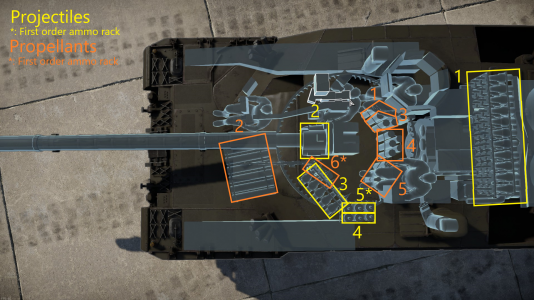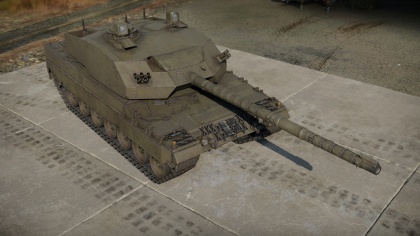Vickers Mk.7
Contents
Description
The Vickers Mk.7 is a rank VII British medium tank
with a battle rating of 10.7 (AB/RB/SB). It was introduced in Update 1.93 "Shark Attack".
General info
Survivability and armour
Describe armour protection. Note the most well protected and key weak areas. Appreciate the layout of modules as well as the number and location of crew members. Is the level of armour protection sufficient, is the placement of modules helpful for survival in combat? If necessary use a visual template to indicate the most secure and weak zones of the armour.
Mobility
| Game Mode | Max Speed (km/h) | Weight (tons) | Engine power (horsepower) | Power-to-weight ratio (hp/ton) | |||
|---|---|---|---|---|---|---|---|
| Forward | Reverse | Stock | Upgraded | Stock | Upgraded | ||
| Arcade | 81 | 37 | 54.6 | 2,032 | 2,862 | 37.22 | 52.42 |
| Realistic | 73 | 33 | 1,327 | 1,500 | 24.3 | 27.47 | |
Armaments
Main armament
The Mk. 7 uses the same L11A5 120mm rifled gun that the Challenger I uses. Shell loadout is identical and works well for mid-Cold War era tanks such as the Type 90, Leopard 2A4, T-64/T-72/T-80B, etc., but may struggle when fighting more modern vehicles such as the Leopard 2A5, T-80U, Leclerc, etc.
| 120 mm L11A5 | Turret rotation speed (°/s) | Reloading rate (seconds) | |||||||||||
|---|---|---|---|---|---|---|---|---|---|---|---|---|---|
| Mode | Capacity | Vertical | Horizontal | Stabilizer | Stock | Upgraded | Full | Expert | Aced | Stock | Full | Expert | Aced |
| Arcade | 50 | -10°/+20° | ±180° | Two-plane | 29.5 | 4.08 | 49.6 | 54.9 | 58.4 | 7.8 | 6.9 | 6.4 | 6.0 |
| Realistic | 18.4 | 21.7 | 26.4 | 29.1 | 31.0 | ||||||||
Ammunition
| Penetration statistics | |||||||
|---|---|---|---|---|---|---|---|
| Ammunition | Type of warhead |
Penetration @ 0° Angle of Attack (mm) | |||||
| 10 m | 100 m | 500 m | 1,000 m | 1,500 m | 2,000 m | ||
| Shell L31A7 | HESH | 152 | 152 | 152 | 152 | 152 | 152 |
| Shot L23 | APFSDS | 410 | 408 | 405 | 400 | 390 | 380 |
| Shot L23A1 | APFSDS | 396 | 394 | 387 | 376 | 367 | 357 |
| Shell details | |||||||||
|---|---|---|---|---|---|---|---|---|---|
| Ammunition | Type of warhead |
Velocity (m/s) |
Projectile Mass (kg) |
Fuse delay (m) |
Fuse sensitivity (mm) |
Explosive Mass (TNT equivalent) (g) |
Ricochet | ||
| 0% | 50% | 100% | |||||||
| Shell L31A7 | HESH | 670 | 17.1 | 0.4 | 0.1 | 5,248 | 73° | 77° | 80° |
| Shot L23 | APFSDS | 1,535 | 3.89 | N/A | N/A | N/A | 76° | 77° | 78° |
| Shot L23A1 | APFSDS | 1,535 | 3.89 | N/A | N/A | N/A | 78° | 80° | 81° |
| Smoke shell characteristics | ||||||
|---|---|---|---|---|---|---|
| Ammunition | Velocity (m/s) |
Projectile Mass (kg) |
Screen radius (m) |
Screen deploy time (s) |
Screen hold time (s) |
Explosive Mass (TNT equivalent) (g) |
| L34 | 670 | 17.1 | 20 | 5 | 25 | 50 |
Ammo racks

| Full ammo |
Ammo type |
1st rack empty |
2nd rack empty |
3rd rack empty |
4th rack empty |
5th rack empty |
6th rack empty |
Visual discrepancy | |
|---|---|---|---|---|---|---|---|---|---|
| 50 | Projectiles Propellants |
47 (+3) 47 (+3) |
15 (+35) 18 (+32) |
10 (+40) 15 (+35) |
7 (+43) 9 (+41) |
1 (+49) 4 (+46) |
N/A 1 (+49) |
No | |
Notes:
- Due to British two stage ammunition, projectiles are marked with numbers (1, 2, etc.), and propellants are marked with numbers preceded by C (C1, C2, etc.).
- In the case of projectiles racks 1 and 4 and propellants racks C3 and C6, the first half are taken out first, and the second half at a later time, and are therefore referred to as two racks.
Machine guns
| 7.62 mm L8A2 | ||||
|---|---|---|---|---|
| Mount | Capacity (Belt capacity) |
Fire rate (shots/minute) |
Vertical guidance |
Horizontal guidance |
| Coaxial | 2,000 (200) | 600 | N/A | N/A |
Usage in battles
Describe the tactics of playing in the vehicle, the features of using vehicles in the team and advice on tactics. Refrain from creating a "guide" - do not impose a single point of view but instead give the reader food for thought. Describe the most dangerous enemies and give recommendations on fighting them. If necessary, note the specifics of the game in different modes (AB, RB, SB).
Modules
| Tier | Mobility | Protection | Firepower | |||
|---|---|---|---|---|---|---|
| I | Tracks | Parts | Horizontal Drive | |||
| II | Suspension | Brake System | FPE | Adjustment of Fire | NVD | |
| III | Filters | Crew Replenishment | Elevation Mechanism | L34 | Smoke grenade | |
| IV | Transmission | Engine | Artillery Support | Shot L23A1 | Laser rangefinder | |
Pros and cons
Summarise and briefly evaluate the vehicle in terms of its characteristics and combat effectiveness. Mark its pros and cons in a bulleted list. Try not to use more than 6 points for each of the characteristics. Avoid using categorical definitions such as "bad", "good" and the like - use substitutions with softer forms such as "inadequate" and "effective".
Pros:
Cons:
History
In the mid 1980's, Vickers Defence Systems developed a new MBT as a private venture to find a successor to the Challenger back in following official specifications. The Vickers Mk.7 is a further development of the earlier Vickers Mk.4 Valiant main battle tank. The tank was very similar to the Mk.4, using the same "Valiant" or universal turret that the Mk.4 used, but being built with a Leopard 2 chassis, along with an MTU engine supplied by Krauss-Maffei. The tank was never adopted into service by the British Army, but its design was used as a base for the Challenger II MBT. The Vickers Mk.7 tank was actively offered for export, however it also received no production orders from other countries. Therefore only one Vickers Mk.7 prototype has been built.
Despite its naming, the tank has no relation to the Mk.1 Vickers MBT sitting at rank V.
Devblog
Following the failure of the previous Mk. 4 Valiant project, Vickers continued work on their design, confident in its success. As a result, Vickers developed the Mk.7 tank in the late 1980s on the basis of the previous Mk.4, hoping that it could be seen as a potential replacement for the Challenger 1. The new Mk.7 featured the existing turret of the Mk.4, though fitted to a Leopard 2 chassis.
Contrary to expectations, the British armed forces didn’t procure the Mk.7, and so, the focus shifted towards the export market, similarly as was the case with the Mk.4 Valiant. Vickers developed an improved version of the vehicle, capable of mounting a variety of different 120mm cannons, in an effort to attract foreign interest. However, the high cost of the Vickers Mk.7 achieved only the contrary, with potential foreign interest being lost to other, more economical designs on the market.
Additionally, by the end of the 1980s, Germany imposed a ban on military equipment sales to countries in unstable regions, mainly those in the Middle East. Vickers, using the German-built Leopard 2 chassis, was therefore prevented from making sales to the most promising potential buyer of the Mk.7 - the United Arab Emirates.
Due to the high production costs resulting in low foreign interest in the vehicle, as well as dependency on outside factors, further development of the Vickers Mk.7 was officially halted, with only a single prototype being built for testing. However, although the Vickers Mk.7 itself became, in the end, another failed project, much of the experiences gained during its development found use in the creation of the far more successful Challenger 2.
Media
See also
- Vickers MBT — The early little brother of the Mk.7.
- Challenger Mk.2 / Challenger Mk.3 — The predecessors.
- Challenger 2 — The production model.
External links
| Britain medium tanks | |
|---|---|
| Valentine | Valentine I · Valentine IX · Valentine XI |
| Cromwell | Cromwell I · Cromwell V · Cromwell V (RP-3) |
| Cromwell derivatives | Challenger · Avenger · Comet I · Comet I "Iron Duke IV" · Charioteer Mk VII |
| Centurion | Centurion Mk 1 · Centurion Mk.2 · Centurion Mk 3 · Centurion Mk.5 AVRE · Centurion Mk 10 · Centurion Action X · FV4202 |
| Vickers MBT | Vickers Mk.1 · Vickers Mk.3 · Vickers Mk.7 |
| Chieftain | Chieftain Mk 3 · Chieftain Mk 5 · Chieftain Mk 10 |
| Challenger 1 | Challenger Mk.2 · Challenger Mk.3 · Challenger DS |
| Challenger 2 | Challenger 2 · Challenger 2 (2F) · Challenger 2 TES · Challenger 2 OES · Challenger 2E · Challenger 2 Black Night |
| Challenger 3 | Challenger 3 TD |
| Australia | A.C.I · A.C.IV · Centurion Mk.5/1 |
| South Africa | Olifant Mk.1A · Olifant Mk.2 · TTD |
| India | Vijayanta · Bhishma TWMP |
| Israel | ▄Sho't Kal Dalet |
| Jordan | Khalid |
| Sweden | ▄Strv 81 (RB 52) |
| USA | Grant I · Sherman II · Sherman Firefly · Sherman IC "Trzyniec" |





